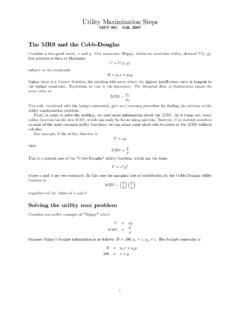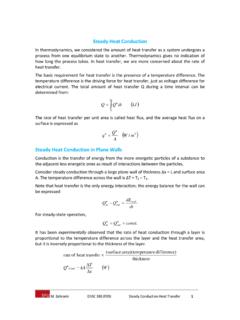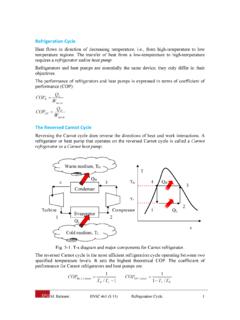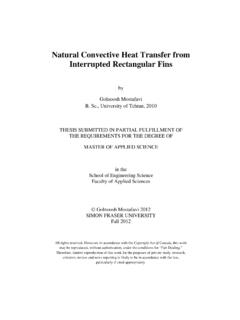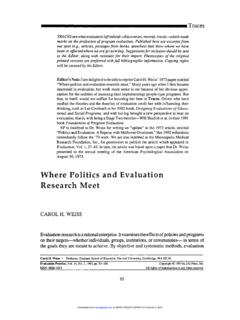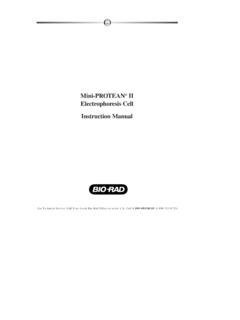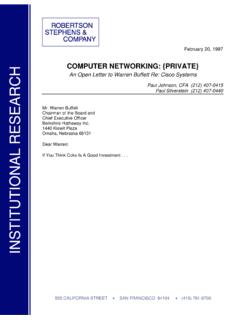Transcription of THE WARREN BUFFETT WAY - SFU.ca
1 THE WARREN BUFFETT WAYI nvestment Strategies of the World s Greatest InvestorROBERT G. HAGSTROMMAIN IDEAW arren BUFFETT is one of the most successful stock market investors of the past 30 entire approach is to focus on the value of the business and its market price. Once BUFFETT finds a business he understandsand feels comfortable with, he acts like a business owner rather than a stock market speculator. He studies everything possibleabout the business, becomes an expert in that field and works with the management rather than against them. In fact, often hisfirst act on buying shares in any company is to grant the managers his proxy vote for his shares to assure them that he has nointention to try and move the company away from its core champions the value investment strategy, and puts no credence in day to day movements in share prices, the impact ofthe economic mood overall or any other external factors.
2 He maintains a long-term perspective at all times, and never loses sightof the underlying value of a BUFFETT APPROACH TO INVESTMENT1. Never follow the day to day fluctuations of the stock market only exists to make it easier to buy and sell, not to set values. Keep an eye on the market only for someone whois willing to sell a stock at a not-to-be-missed Don t try and analyze or worry about the general you can t predict what the stock market will do from day to day, how can you reliably predict the fate of the economy?3. Buy a business, not its a stock purchase as if you were buying the entire business, using the following tennets:Business Tennets1. Is the business simple and understandable from your perspective as an investor?2. Does the business have a consistent operating history?3. Does the business have favourable long-term Tennets1.
3 Is management rational?2. Is management candid with its shareholders?Financial Tennets1. Focus on return on equity, not earnings per Calculate "Owner Earnings".3. Search for companies with high profit For every dollar of retained earnings, has the company created at least one dollar s extra market value?Management Tennets1. What is the value of the business?2. Can the business currently be purchased at a significant discount to its value?4. Manage a portfolio of investing means having the priorities of a business owner (focused on long-term value) rather than a stock trader(focused on short-term gains and losses).1. WARREN BUFFETTIn the 1993 Forbes list of America s richest people, WarrenBuffett had an estimated net worth of $ billion. Of all 69 peoplelisted, BUFFETT is the only one who obtained his wealth from thestock graduated from the University of Nebraska.
4 While there,he read a book The Intelligent Investor by Benjamin book so impressed BUFFETT that he went to New York to studywith Ben Graham at the Columbia Graduate Business the age of 25 in 1956, BUFFETT started an investmentpartnership. He had seven limited partners who contributed$105,000 and BUFFETT as general partner put in $100. The limitedpartners received 6-percent interest per year and 75-percent ofthe profits generated above this level. BUFFETT was paid the other25-percent. Over the next 13 years, this partnershipcompounded investments at an annual rate of In1965, BUFFETT closed the partnership and cashed out with apersonal stake of $25 BUFFETT used his capital to purchase a controlling interestin Berkshire Cotton Manufacturing, a well established butstruggling textile company.
5 This company merged withHathaway Manufacturing, and also bought interests in twoinsurance companies in 1967. The combined company wasrenamed Berkshire insurance companies generated steady cash flow, whichwas invested in stocks and bonds to have the funds available forpayment of claims. The company s stock portfolio in 1967 was$ million, so BUFFETT assumed control of this. Within two years,the stock portfolio had grown to $42 million, and the insurancecompany profits far outweighed the return generated by thetextile side of the the 1970s, Bershire bought three more insurancecompanies and started another five. BUFFETT also closed thetextile side of the company and converted Berkshire Hathawayinto a holding company. Berkshire owns a number of other variedcompanies which generate good returns on equity without usingdebt.
6 By 1993, the noninsurance side of Berkshire-Hathawaygroup had a sales turnover of $ billion and earned $176 millionafter tax - about 37-percent of the gorup s operating BUFFETT and his wife now own around 40-percent of thestock of Berkshire-Hathaway. He works as Chief Executive ofthe company for an annual salary of $100,000 per year. Manyof his employees who manage different parts of the companyearn much had a corporate net worth of $22 millionwhen WARREN BUFFETT assumed control. Today, it is worth morethan $ billion. BUFFETT s goal is to increase the company sworth by a 15-percent compound rate each pays no dividends but reinvests all money , shareholders look to a capital gain in the value of theirstock. Since 1964, Berkshire shares have grown from $19 eachto more than $22,000 per share today.
7 Over the past 25-years,Berkshire has grown at an compound rate of peryear - well above BUFFETT s target of 15-percent per TWO MENTORSMain IdeaWarren Buffet s investment methodology is a hybrid mix of thestrategies put forward by two 1930s style investment advisers,Ben Graham and Philip Graham, BUFFETT learned the margin of safety approach -that is, use strict quantative guidelines to buy shares incompanies that are selling for less than their net working also emphasized that following the short-termfluctuations of the stock market is pointless, and that stockpositions should be long Fisher, BUFFETT added an appreciation for the effect thatmanagement can have on the value of any business, and thatdiversification increases rather than reduces risk as it becomesimpossible to closely watch all the eggs in too many GrahamAuthor of Security Analysis and The Intelligent Investor,Graham is widely considered as the first professionalfinancial Graham grew up in New York and had a science degreefrom Columbia University.
8 By the age of 25, he was a partnerin a brokerage firm earning $600,000 per year. He wasfinancially ruined by the 1929 crash and had to rebuild s investment philosophy was that a well-chosen,diversified portfolio of common stocks, based on reasonableprices, were the soundest possible long-term investmentanyone could Graham, the distinction between an investment and aspeculation was: An investment operation is one which,upon thorough analysis, promises safety of principal and asatisfactory return. Operations not meeting thoserequirements are speculative. An investment requires safety of principal and a satisfactoryreturn. Safety is a relative term, and can never be determinedin an absolute sense. Similarly, the concept of a satisfactoryreturn (whether dividend income or stock price appreciation)is also described three approaches to investing in commonstocks:1.
9 The Cross-Section investor buys some shares in companies in every sectorof the market. Then, whatever happens in the economy, atleast one stock will be performing The Anticipation Short-Term is the investment in companies which have the mostfavourable outlook in the next 6-months to a year. Althoughthis is volatile and superficial, this is the dominant approachused by most Growth StocksThese are companies whose sales and earnings areexpected to grow at a rate above those of the averagebusiness. The trick is to buy stock in any company whoseproducts were at an early stage of their life cycle, when profitsand revenues were just about to take off. The difficulty hereis in accurately forecasting rates of WARREN BUFFETT Way - Page 2 -3. Margin of Safety ApproachInvest only in companies which have a large margin betweenearnings and fixed costs.
10 In a downturn, that company ismost likely to ride out a recession well. Applying this conceptto a stock, buy shares only in a company for which the shareprice is below its intrinsic value as determined by assets,earnings, dividends and future strongly advocated the margin of safety approachwith investment in common stock of growth companies. Hisapproach to investment was to purchase growth companyshares when the overall market is trading at a low price orwhen growth company shares are trading below theirintrinsic value. However, since buying at market lows iseveryone s objective, there is no competitive advantage inthat approach. Therefore, Graham suggested that identifyingundervalued stocks, regardless of market sentiment, was thekey to stock market investment value is closely linked to a company s future earningpower and fixed costs.
